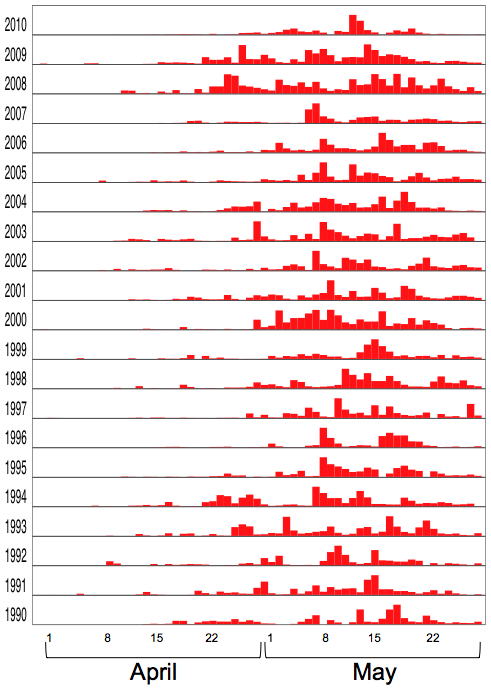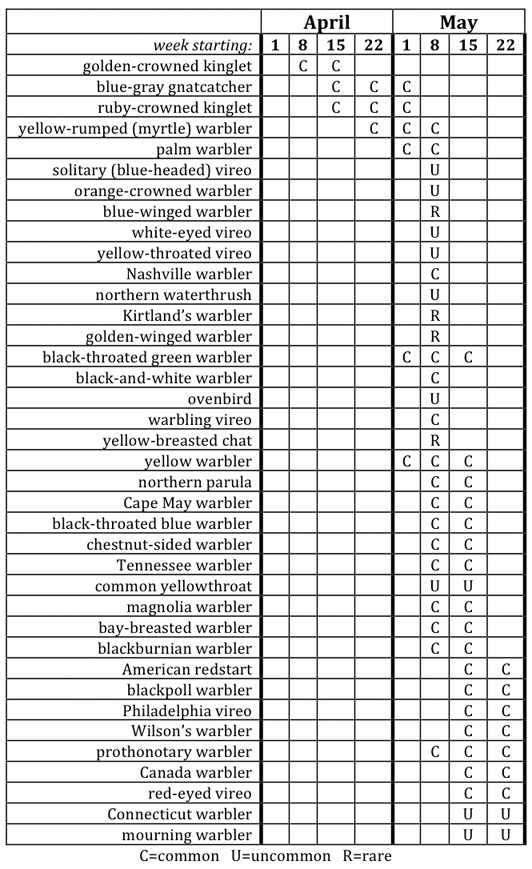

|
||||||||
Planning a Trip To Magee MarshThis page is intended to help you plan a trip to Magee Marsh in the spring for the warbler migration. The best time to go is from late April to late May, with the peak being around May 14th. Individual sections below deal with specific issues such as travel and lodging.
Directions and Travel OptionsMagee Marsh is located off of route 2, about forty minutes from Toledo. See the Maps page for a driving map. You can fly into Cleveland, Detroit, or Columbus and drive to Toledo, or possibly take a smaller plane to Toledo's airport. When driving on route 2, keep an eye out for the signs for Magee Marsh. The park is located next to Ottowa National Wildlife Refuge, and is just west of the intersection of route 2 and route 19 (which goes to Oak Harbor). Route 2 continues all the way to Port Clinton, in case you opt to stay there. If you stay in Oak Harbor, Fremont, or Clyde, you'll be coming in from route 19.When you get to the park, you'll see the BSBO visitor center immediately on the left. During the festival, this is where you can register. To get right to the birding hotspot, however, continue on the main access road to the very end, where you'll find three enormous parking lots. Continue to the last lot, where you'll find the west entrance to the boardwalk. See the trail map on the Maps page. When to GoThe peak for spring warbler migration through Magee is in May, generally around the 14th. Though the birding festival has traditionally spanned the first two weeks in May, many visitors find the peak bird activity to be roughly from the 10th through the 18th. Keep in mind that as spring progresses, the foliage at Magee becomes more dense, making it harder to see (and especially photograph) the birds. See the section on Timing of Migration for more details.Where to StayThe most convenient option for lodging is Toledo, where you'll find many hotels and also many restaurants. If you instead opt to stay in Oak Harbor, Fremont, or Clyde, you'll find that your drive time is roughly the same, but you'll have fewer options for meals (in many cases consisting primarily of fast food). Another option is Port Clinton, which is east of Magee. To find a hotel, go to orbitz or travelocity and search for hotels near Oak Harbor. Before booking a hotel through orbitz or travelocity, first call the hotel and ask if they're offering a birder's rate or a fisherman's rate, and if so, book with them directly over the phone.Where to EatMagee is somewhat isolated, being situated away from any cities or even small towns. The best bet for meals is to take breakfast and dinner in the city where you stay (Toledo is a good option for this) and to pack a lunch. The nearest grocery store would be in Port Clinton to the east or Fremont to the south. A few convenience stores with snacks can be found east and west of Magee on route 2. There are restaurants in Oak Harbor and Martin.Time of DayBirding at Magee Marsh goes on all day long. Many birders like to arrive at the park around 8am. There are no gates at the park entrance, so you can come and go at any time of day. On good days in May many photographers put in twelve or more hours in the field.Weather PatternsThe biggest factors in determining bird abundance at Magee are timing and weather. Winds out of the south bring the birds to Magee, but also push them away across the lake. When winds out of the south suddenly turn and blow hard from the north, the birds that have just arrived will stay at Magee until the winds turn again. Under these conditions you can see large numbers of migrants that are stuck at Magee waiting for better weather. Note also that rainy days can sometimes produce the best birding, because the rain knocks the insects down to lower branches of the trees, and then the birds come down to eat the insects.Kaufman's PredictionsFamous birder Kenn Kaufman provides daily predictions on his blog, and many of these turn out to be correct. When Kenn predicts a fallout at Magee it's a good bet that you'll see lots of birds. Kenn's predictions often extend over several days or a week, so if you're still in the process of planning your trip in late April or early May, visiting Kenn's blog can help you to decide whether to shift your stay forward or back a few days. Remember that the timing of the migration varies quite a bit from year to year. You can also get a feel for how this year's migration is coming along by visiting the BSBO banders' blog.Other Nearby SitesOther local sites for birding include Ottowa NWR and Metzger Marsh (located right next to Magee) and Maumee Bay State Park (located about 15 minutes west on route 2). In Toledo there's also a popular city park called Oak Openings, where red-headed woodpeckers nest. If you take part in the birding festival, there are also organized trips to places such as Point Pelee and Pelee Island.Timing of MigrationThe warbler migration through Magee is often described in popular literature as occurring in three "waves"1. Unfortunately, the actual timing of migration is a bit more complicated than that. As you can see from the following chart, the abundance of warblers at Magee varies wildly from day to day, and the overall pattern varies from year to year and is highly unpredictable: Yearly variation in the timing of warbler migation at Magee. The height of each red bar is an indication of how many birds were present that day. Each track is for a different year. (Based on public domain data from USGS BBL/BSBO2) Nevertheless, when averaged over many years, strong trends can be identified. These trends clearly indicate that the second and third weeks of May are the most productive, in terms of both the species diversity and the absolute number of birds. However, some species are more likely to be seen earlier or later in the month, so if there are particular species of warblers that you're interested in, the following chart will be useful to you. This chart shows which species are expected to be seen during each week in April and May at Magee (C means common, U is uncommon, and R rare):  (Based in part on
public domain data from USGS BBL/BSBO2)
As you can see from the chart above, kinglets, gnatcatchers,
yellow-rumped warblers and palm warblers pass through Magee early in
the season, so if these are of special interest to you, then you'll
want to plan to visit Magee earlier in the season. Most of the
other species can be seen during the second and third weeks at
Magee. The latest migrants, which pass through during the third
and fourth weeks, include primarily Wilson's, Canada, Connecticut, and
mourning warblers, so if these interest you then you'll want to
concentrate your visit on the third and fourth weeks in May (but keep
in mind that this late in the month the emerging foliage can become a
significant impediment to seeing and/or photographing the birds).
Note also that several species of warblers breed locally at Magee,
including prothonotaries, yellows, common yellowthroats, and warbling
vireos, and that these can often be seen over a longer interval than
indicated by the chart above.Keep in mind that not all birds in the table above are seen with equal frequency. For example, prairie, kentucky, cerulean, and worm-eating warblers are fairly rare to see at Magee. Kirtland's warbler is a special case: it seems that in many years this species is reportedly sighted at or near Magee, typically out on the beach. Bona fide sightings are sometimes eventually viewed by hundreds of birders as word spreads via both Twitter and word-of-mouth among the visitors on the boardwalk. The Birding FestivalThe "Biggest Week in American Birding" festival is typically held during the first two weeks at Magee Marsh. The festival involves a number of special events for paid registrants, including lectures from famous bird watchers and guided trips to local sites outside Magee. While a minority of Magee visitors in May do participate in the "official" festival, most opt instead to come to Magee and enjoy independent birding without the additional cost and inconvenience of following a prescribed schedule. It's important to understand that registration for the festival is in no way a prerequisite for enjoying the excellent birding at Magee in May. However, the festival does include some unique programs that you may find highly enjoyable, and the fee goes to a good cause, so it's worth trying out. You can find out more about the festival events and even register online at the festival's official website.1The
idea of bird migration "waves" can be traced back to at least 1891
(see Auk 8:194-200, April 1891).
2"BBL data are in the public domain" -Bruce Peterjohn, USGS BBL chief, August 2, 2011, pers. comm. Data are from the Navarre Marsh Migration Monitoring Banding Station, Black Swamp Bird Observatory. Downloaded with special permission from the United States Geological Survey's Bird Banding Laboratory. |
||||||||
|